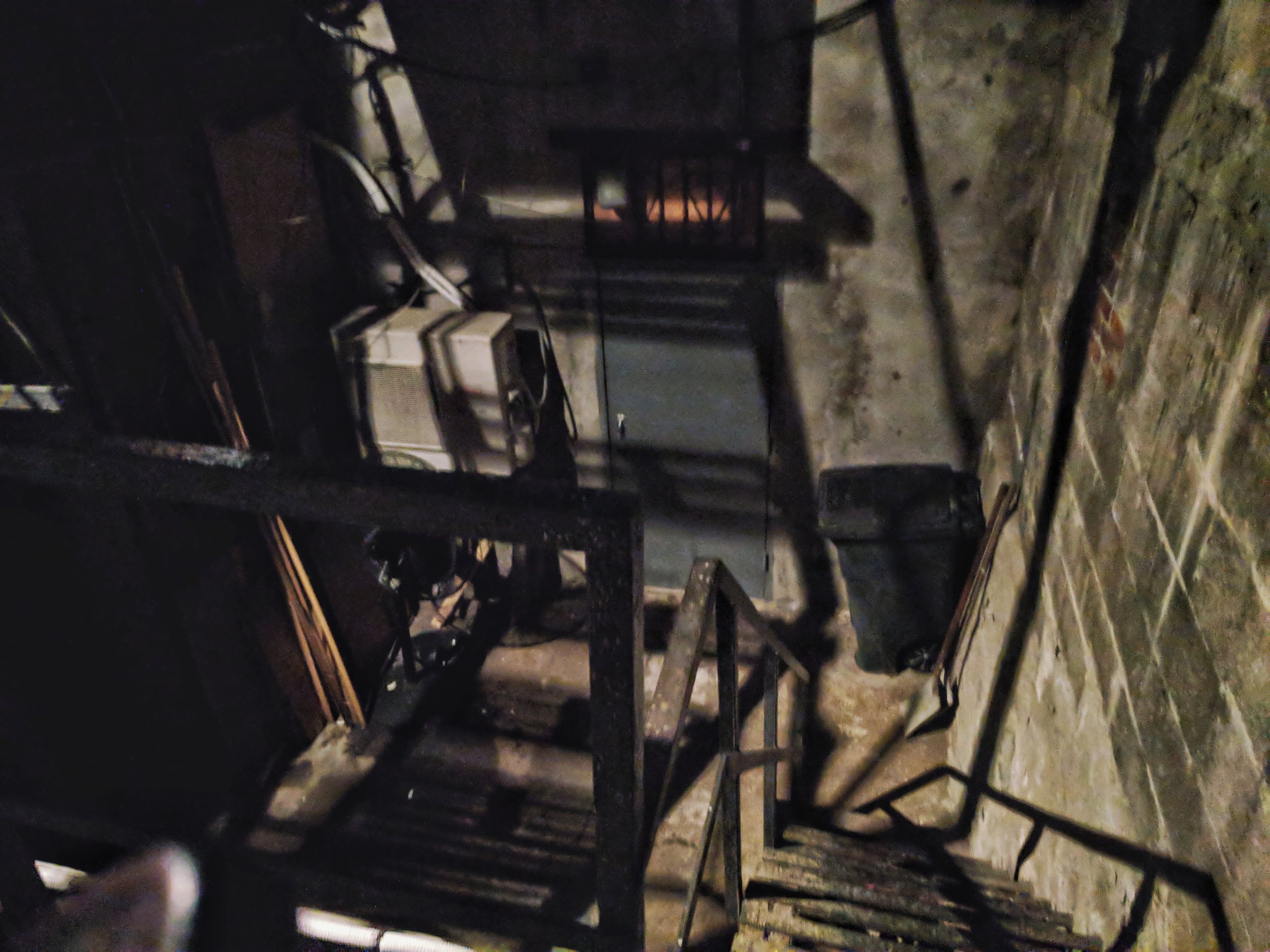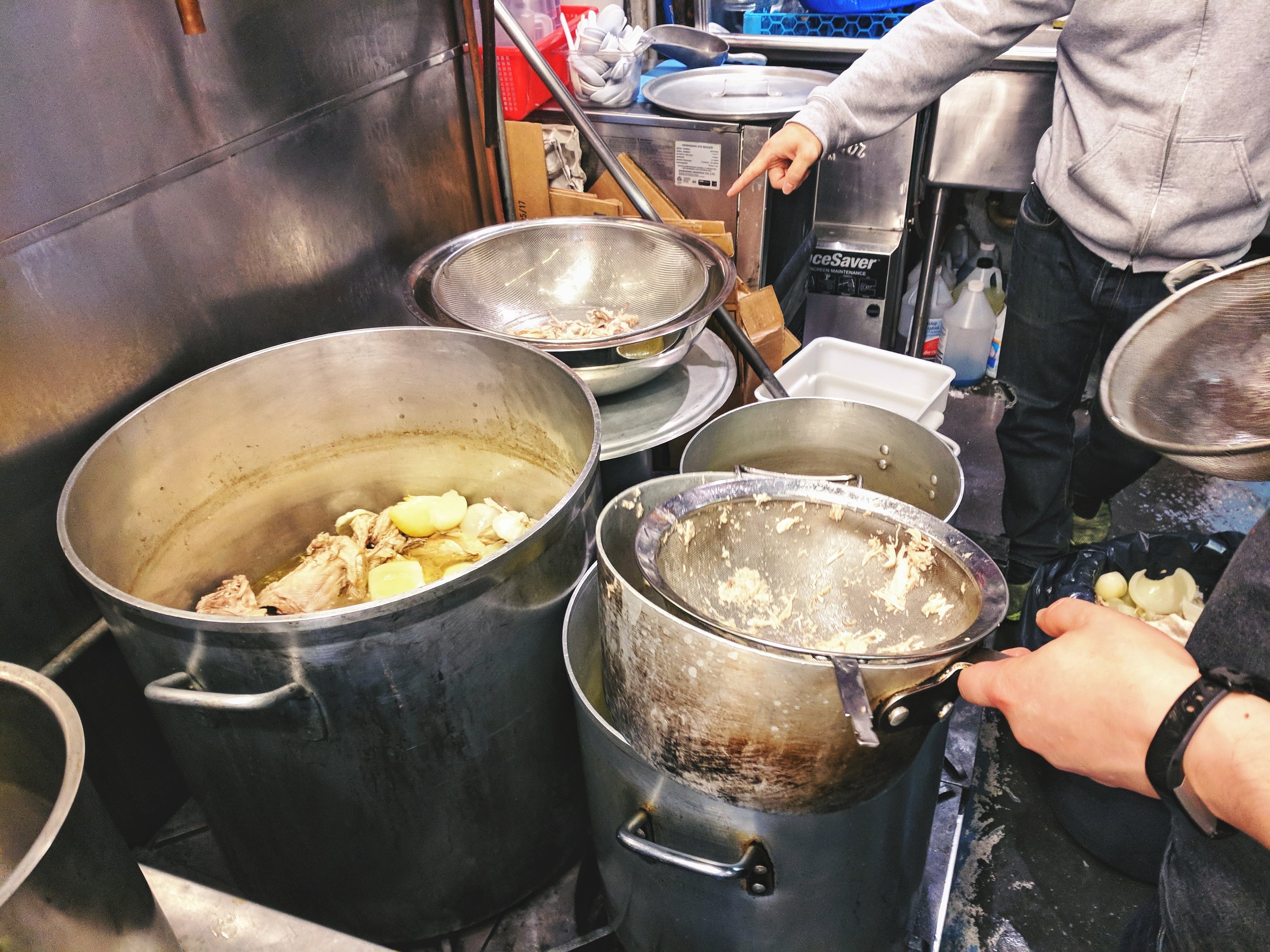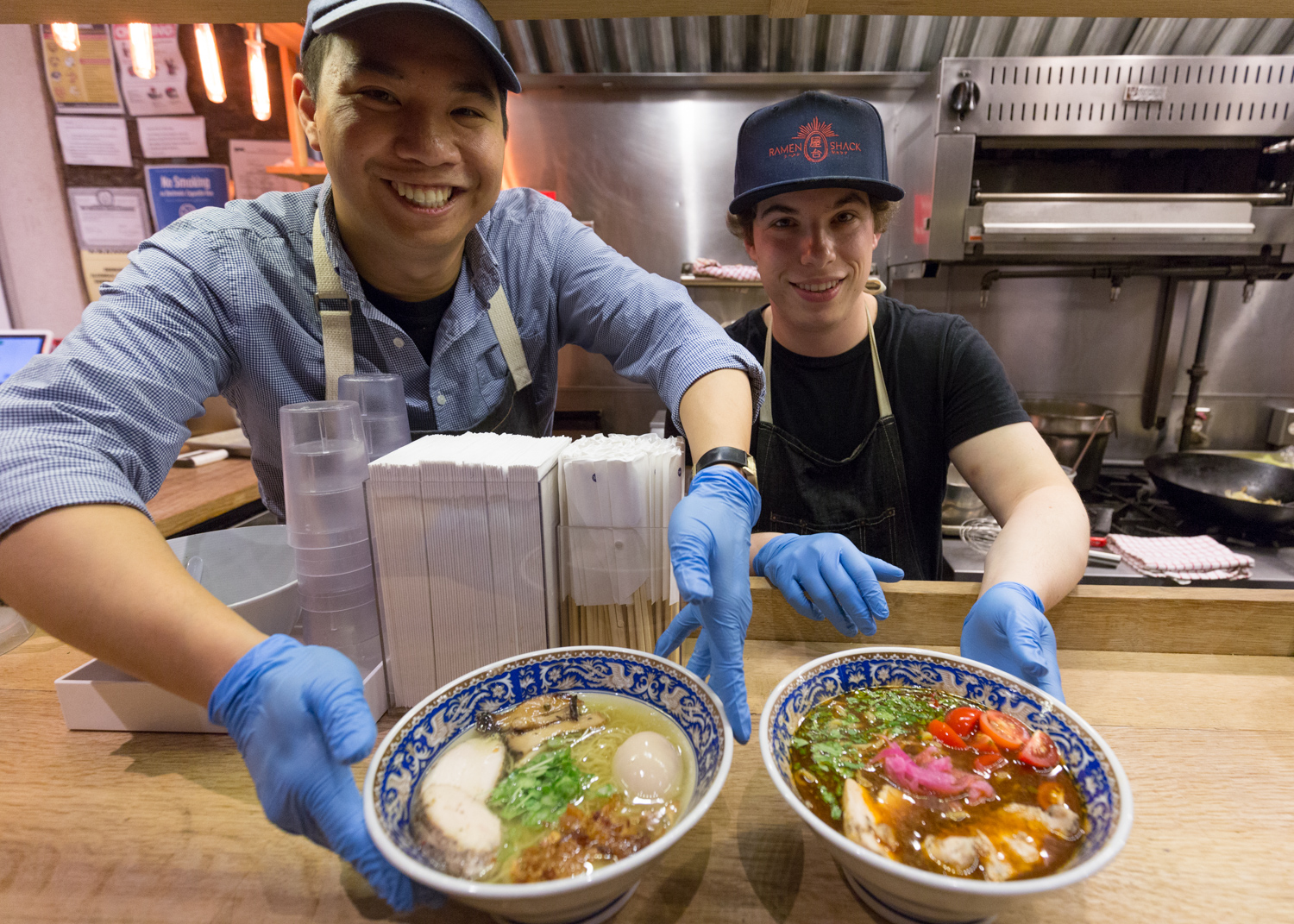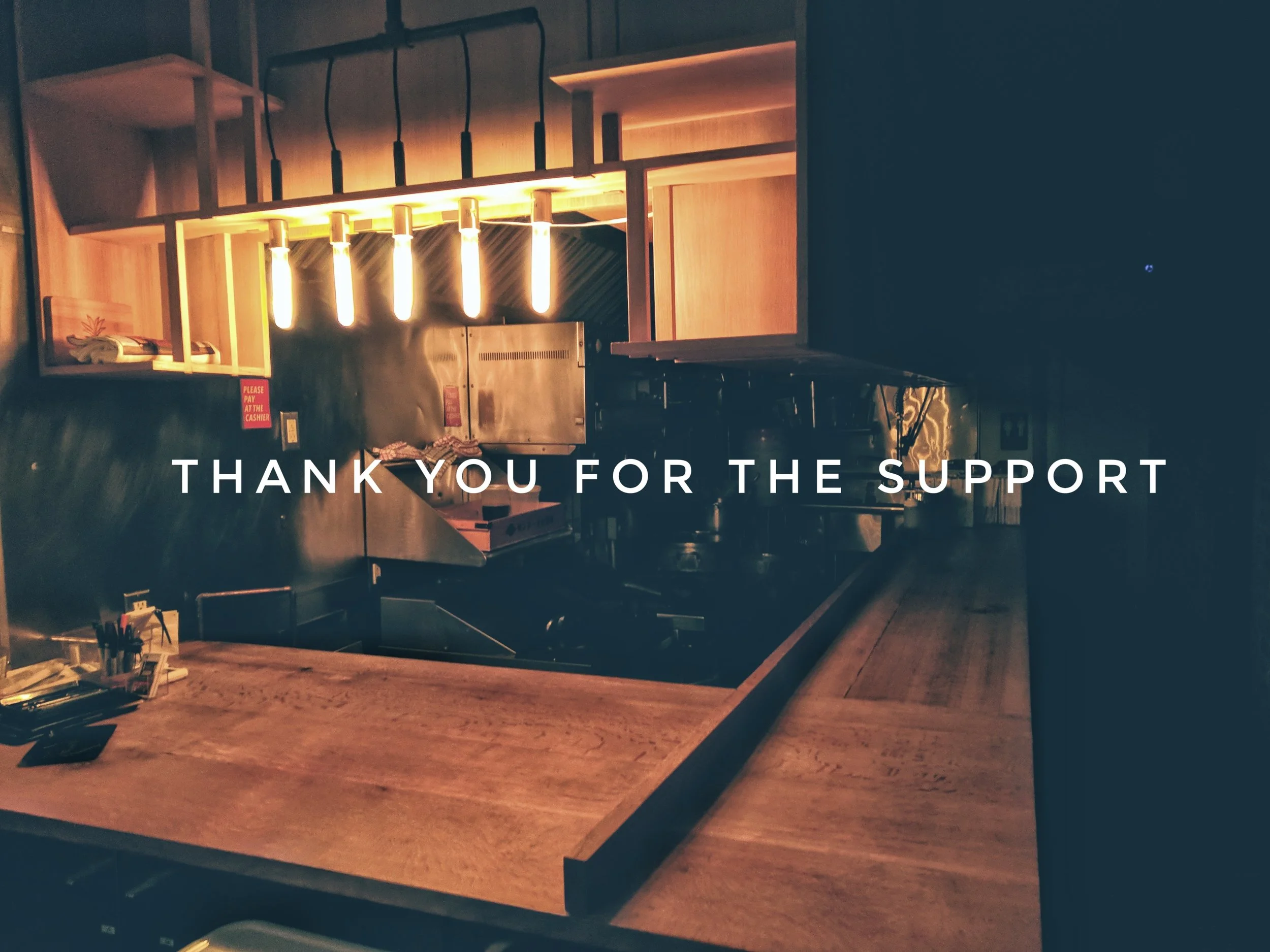Ramen Lab Part 2 - Working at Ramen Lab
/I still cannot believe that I was able to have a pop-up at Ramen Lab in New York. Just preparing for the pop-up was a mental exercise and an adventure of its own. The actual ingredient preparation and cooking for Ramen Lab was a whole nother beast that required the physical conditioning of a marathon runner.
The Day it All Started
On Monday, the day before our opening day, I met up with Mike and the Ramen Lab Team, which consisted of Kanako and Akira. Kanako is the store manager, our main contact for ingredients, logistics, or anything related to the restaurant. Akira is a ramen consultant who has helped opened many ramen restaurants and a ramen master in his own right. Because neither Mike or I was certified as a Food Handler, Akira was there to make sure we didn’t get anyone sick. Essentially our babysitter who would save us if shit hits the fan. Kanako walked us through the restaurant, reviewed restaurant protocol, and handed off the keys to us.
At that time we were waiting on ingredients to be delivered, so we slowly eased into our tasks. We learned how to work the industrial kitchen stoves, the noodle boiler, and of course the sound system! Mike let me have free reign over the music selection, so I picked a jazz and hip hop playlist - the two music genres that come to mind when I think of New York. The eggs and produce came first, so we started with boiling 100 eggs. A common trick to making the perfect ramen egg is to poke a hole in the bottom of the egg using a push pin. Akira told us that it was not necessary because adds a lot of time. Instead, you take the heel of your knife and just nick the shell. All you need to do is make a tiny scratch to help release the air that is trapped at the flat portion of the egg. I was only a few hours in, and I already learned an invaluable lesson. As the rest of the ingredients trickled in we prepared our chicken, chashu and three tares. Somehow the day went by in a flash. We didn’t leave until 11 pm, but little did we know, that would be the earliest that we’d leave Ramen Lab that week.
The Set Up
As you can see this shop is super narrow! It has about 10 standing spots for customers and the little space that is leftover is dedicated to the kitchen.
4 Basket Noodle Boiler - The noodle boiler was in the front corner closest to the door. This is where the order tickets are placed and the noodles are started. The noodle boiler doubles as an awesome egg boiler, where we cooked our custardy 7 minute eggs. The handles of the noodle baskets can get hot if you don’t rotate them in the right direction. I learned the hardway!
Mise en Place Pan Holder - I do not have a good pictures of this, but this is essentially a fridge with an upper compartment for all of your toppings that go into the bowl. It is VERY important to make sure you have everything set up before you start service. When we first started, we only had a pair of chopsticks or two for all of our ingredients. By the end of our pop-up we wised up and had a utensil for each individual ingredient. It streamlined our plating and kept our hands clean.
6 Burner Gas Stove - As a home cook, you always hear from restaurant professionals that there is a huge difference on professional burners, and boy they were right. I felt like I was cooking on a rocket engine. The only downside is that the stove can be finicky on lower heat settings. If you set the flame too low, the flames can go out on you.
Stock Pot Boilers - These 4 stoves were about knee high and was where we made all of our broth. There were pipes that conveyed water directly into the pots which was very convenient. When you are cooking in a 100 qt stock pot, the last thing you want to do is to move around a pot filled with water.
Dishwasher and Sink - Dirty dishes were our worse enemy, so it makes sense that the dishwasher was our best friend. It cleans lightning fast with its run cycle at about 1 and a half minutes. A clean kitchen, a clear mind, and smooth service.
Basement Storage - Because we are in New York, real estate is expensive! Our extra storage was downstairs and had to be accessed through another building. We usually had to lug our bulk ingredients down a dark alleyway and a dimly lit hallway (like something you would see in a horror movie). However, at the end of the scary path, there is a treasure trove. Besides the industrial freezer and fridge, there are a couple of shelves with the leftover ingredients from the past guest chefs. There are boxes filled with assorted kombu and katsuobushi, custom bowls, and misc. soy sauces. Enough ingredients to fill a ramen nerd’s dream.
Opening Day
The day had finally come. It was time to see if the long hours we poured into developing our recipes and the months we spent planning paid off. We arrived at the shop at 8 am bright and early to prep the soup. It takes approximately 6 hours to make the soup and another 30 minutes to strain, so we were tight on time to make it for the 5 pm start of service. The moment we dropped the chicken bones in the giant pot we began chopping away. We had no clue how many of each bowl would sell, so we decided to prepare 100 servings of each. Considering Tuesdays are generally the slowest day of the week, we were told to expect maybe around 70 bowls sold. That sounded totally manageable.
In the middle of the afternoon we got a text from Kanako. “The water is being shut off tomorrow from 8 am to 4 pm.” We haven’t even served our first bowl of ramen and we hit our first road block! It turned out that it was a false alarm, but we did not find out until the next day. The only thing running through our heads was whether or not the Ramen Gods had forsaken us. We had no time to whine and complain and no choice but to sidebar this issue as Ramen Lab was about to open.
In no time, the day hit 4:30 pm. We were joined by Mica who was in charge of taking orders and manning the cashier. Quickly, we made our test bowls before service. Up until this point, Akira nor anyone from Sun Noodle/Ramen Lab, had tried our bowls. If I were them, I would have been nervous, but by this point it was too late. We all pulled out some spoons and chopsticks, took a deep breath and sampled a little bit from each bowl. Everyone had a pleasantly surprised look on their face. We let out a sigh of relief that our bowls tasted how we envisioned, and everyone else had a sigh of relief that the ramen being served was edible. Time to serve ramen!
The doors opened and we manned our battle stations. I was at the noodle boiler, reading orders and timing the noodles. Mike manned the wok and soup station. Between us was the tare and garnish station that was shared between the two of us. Akira held down the fort at the dish washing station. It felt like such a waste of skills and talent for Akira to be doing dishes, but he told us that this was our pop-up and these were our bowls. We should be the ones making it and handing it off to our customers. This was it.
Our customers came through the door, and Mica took their orders on a laminated order form. Each ticket represented one customer, and the party’s name was written down at the top of each. Their order was check on the ticket and their seat assignment was written on the bottom. The tickets that are rotated towards me were for the customers who have been seated, while the tickets rotated the other way are upcoming customers waiting outside. Once I fulfill an order, I flip the tickets face down and move on to the next customer. The system seemed simple enough… or so I thought.
The first order came through and we started slinging soup and noodles. We passed the bowls to the customers who we thought the bowls were going to. “Who had the miso ramen?” I asked. One person raised their hand and we handed the bowl to them. We were about to handle the next bowl which was a Mole Shoyu Ramen, but no one who was sitting down had ordered one. How could we have already messed up? I looked at Mike who was asking me who had who. I looked at Mica who was already adding tickets for the next customer waiting outside. I gathered myself and started to look through the ticketing system again and retraced my steps. It turns out that the customer who thought he ordered a Miso Ramen actually ordered a Mole Shoyu Ramen and was not aware of the difference. It was just a minor mix up looking back at it now, but for this to happen when serving your first customer, it felt like a train wreck.
We quickly recovered from this hiccup. I went over the ticketing system one more time with Mica and pushed the reset button in my head to reboot my ramen making body. We served one bowl of ramen. We served two bowls of ramen. In no time, we served ten bowls and had one minute to recollect ourselves. Ten bowls turned into 20, and the next thing we knew, service was over and we sold 90 bowls! Not bad for opening night.
As 10:20 PM came around and the feeling of relief and pride filled the empty space that our final customers left. Mike and I looked at each other, smiled, and shook hands. “We did it. We really did it”, we told each other. I do not know about Mike, but that moment felt like we were the first people on the moon. As home cooks, we came into Ramen Lab and actually showed that we know a thing or two about ramen. We celebrated quickly with our staff meal, regained the feeling in our feet, and began to clean up and prepare for the next day.
The Schedule
Below is a glimpse of our everyday life at Ramen Lab, or at least a schedule of how I would do it next time. It wasn’t until Day 4 or 5 when we started to really figure things out and streamline tasks.
8:00 am - Open Shop and Start the Soup - Mike and I alternated on who arrived early to begin prepping the soup, so at least one of us could get a decent 6 hrs of sleep. The first thing was to grab the bones from down stairs and bring them up to be washed. 60 pounds of bones were then placed into a 100 quart stock pot and brought to a simmer to be skimmed. While the broth was being brought up to temperature, we would heat up the noodle boiler and start preparing 100 eggs to be boiled.
9:00 am - At this time the other one of us arrives. Just in time, as the skum starts to rise from the bones and requires skimming. We also begin boiling the eggs in batches of about 24 for 7 minutes before being thrown them into an ice bath.
10:00 am - It is time to start chopping ingredients for aroma oils, tare, and soup. At this point the eggs have been boiled and need to be cracked and peeled. We have at least 100, so there is a lot of egg shells.
12:00 pm - Around noon, we will begin prepping our meats. Chicken can be cooked, chilled, and served that day. Chashu is ideally made a day or two prior to service. If we could redo it, we would prepare chashu for several days at a time instead of only making enough for just over one day. Aroma oils and tare are being assembled by this point. The smell of garlic and onions wake us up and allows us to literally run on fumes if we do not have time for a lunch break.
1:00 pm - The chopping begins. There were about two okay knifes that were available at the restaurant. After day one of chopping toppings, I was regretting not bringing my knife. A few days Akira let us use his super nice knives. By day 4, Mike stopped by Korin and picked him up a sweet knife! It also gave me an excuse to leave the chopping to him.
2:00 pm - At this time, we have a 1 hour warning that the soup is going to be done. We throw in the aromatics and assess what is left that needs to be done. This is usually where we have the "Oh Shit" moment. If we need to pick up the slack on something, this is when we would hustle to get things done.
3:00 pm - The soup is finally done and the straining begins. We use a tiny pot to scoop soup out of the giant pot, and strain it into two medium size pots. The scraps are then dumped into a moderately sized pot. There are definitely a lot of pots involved. Once the soup is strained, we skim the chicken fat or chiyu off for the next day's aroma oils. At this time, the chilled meats will be sliced for service.
4:00 pm - One hour before service starts. Hopefully by this point all our ingredients are chopped, the soup fully strained, and everything is clean. We begin laying out our ingredients, tare, oils, soup and noodles.
4:30 pm - With 30 minutes left, we make our test bowls. We are not only confirming that everything is edible, but we do this to make sure that our set up is correct. This allows us to check if there is a utensil for each topping, that the salt is in the right place for stir frying, or look out for anything else that may have been over looked.
5:00 pm - The doors swing open and customers come in. Receiving the first ten customers can be the most stressful for inexperienced ramen chefs like us. When you see 10+ order tickets in front of you, your brain starts to get overwhelmed. The reality is we only have 4 noodle baskets, so you only have to make 4 bowls at a time at most. There is no need to rush. Once I realized all the limitations and constraints, I was able to concentrate on the bowls in front of me. Assembling a bowl of ramen was a dance with Mike. It is about being where your partner is not and using all your senses. Touch, Hearing, Smell, and Taste. Serving customers is hands down the best part of the day. You spend 10+ hours out of your day preparing for this moment, so you gotta enjoy it.
10:00 pm - Once the clock strikes 10 pm we stop taking orders and wait for the last of our customers to leave. It feels like one of those Cinderella moments where the party ends and your carriage turns into a pumpkin. We are happy that we were able to experience the thrill of serving ramen, but the daunting task of clean up and prep for the next day looms over our heads.
10:30 pm - Before we completely shut off the noodle boiler, we prepare a family meal. If the day was super busy, this could be one of our first meals of the day. At this point our feet are shot and we pull out a stool to rest our feet for 20 minutes or so before we have jump back on them and clean.
11:00 pm - Clean up. Someone has to do it. All the perishables get placed into the fridge, all the surfaces are wiped down, and noodle boiler needs to be scrubbed down! Oh how I hate scrubbing the noodle boiler.
the experience and friends
I tell people all the time that cooking ramen at Ramen Lab was literally living the dream, and it is true. Not only was I able to serve 500 bowls of ramen, but I became part of the awesome NYC ramen community for a week. Ramen chefs and ramen lovers from NY came by to support us like Keizo Shimamoto (who ate 3 bowls in one sitting!), Kyle, Tip, Josh Reisner (came by 3 times), Kano (who took some great photos), and the guys from Brooklyn Ramen. Your support and messages throughout the week kept us going. I was also able to meet Jiro Anma of Menya Jiro who came by tried my shio ramen. Right after he ordered an extra serving of noodles, he told me that our ramen could hold its own against a lot of shops in Japan. Wow. At that moment, I felt like the many long hours I spend making ramen were validated. It is an amazing feeling to know that your hard work finally paid off.
Customers from all over the city swung by to grab a bowl. There were people who came multiple times or had multiple bowls! Thank you to the crazy number of members of /r/ramen also came out and showered their support for us ! I was able to reconnect with friends who I haven't seen for a while and make new ones as well! Friends of friends also came out to support me. I can't thank everyone who came out enough!
I was able to finally meet up with Mike Satinover, the Ramen Lord himself, in person. We banded together as home cooks to show the world that we in fact do know something about ramen, and we can compete with everyone else out there. We did it!
So what is next? I seriously thought I would be burnt out at this point, but this experience has turned up my passion for ramen. After our last day of service, Akira made us a bowl of his Gyukotsu Miso Ramen. This was really a life changing bowl that blew my mind. I thought I knew a good amount about ramen, but this bowl left me speechless. My body was beat and battered after working 16+ hour days for 6 days, but my mind and heart wanted to keep making ramen. It really says something about how this pop-up has affected my life. Moving forward I will probably not open up a restaurant, but I am not against the idea of doing pop-ups regularly. The aspect I loved the most about this pop-up experience being able to chat with customers who also shared a love for ramen. I don't know where this ramen journey will take me next, but what I do know is that there will be plenty of noodles in my future.
























